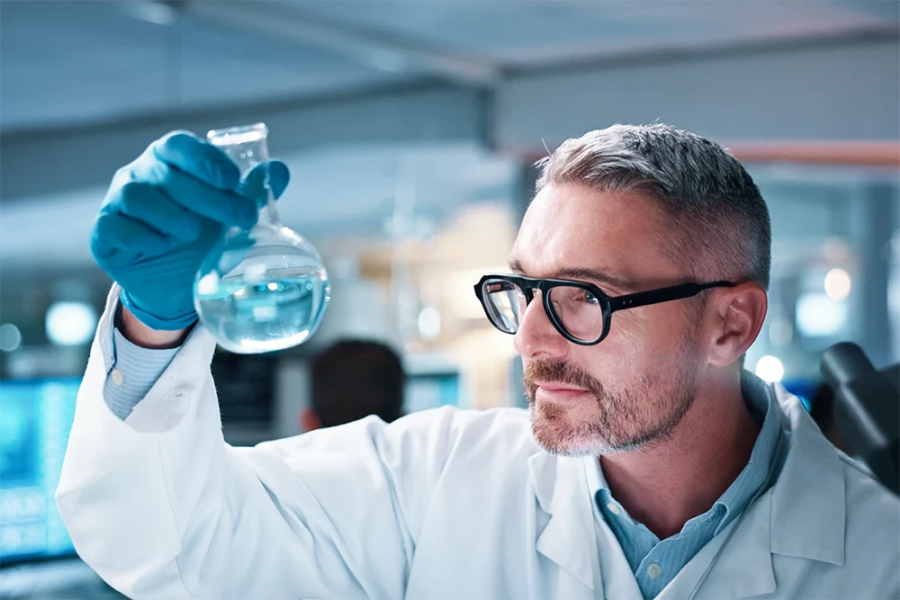Water purification refers to the removal of impurities such as dissolved minerals, sediment (mud), salts, microbes, and organic compounds from water.
There are various ways to purify water, with common methods including filtration, distillation, desalination, and deionisation.
If you’re studying GCSE chemistry, you’re probably already familiar with some of these processes – you may have even performed a water purification experiment yourself in the science laboratory.
In this article, we explain exactly what water impurities are and how the water purification process works. You’ll also find step-by-step instructions so you can conduct some simple water purification experiments of your own.
In this post:
Learning objective: how to purify water
It’s important to understand that purifying water isn’t the same as merely boiling it. Although boiling is necessary when purifying water through distillation, it’s just one step in the process. While boiling can kill microbes and potential pathogens, organic and inorganic impurities remain in water.

There are several methods of purifying water, but for the purposes of this guide, we’ll just focus on those that can be easily performed in a school laboratory. By the end of this article, you’ll understand how to perform basic water purification processes including boiling, filtration, and distillation.
Understanding water impurities
Untreated water, such as seawater and spring water, contains impurities that must be removed for it to be considered safe to drink. Seawater is a mixture of around 96.5% water and 3.5% salts.
Aside from sodium chloride, which makes up the majority of the salt content, seawater also contains trace amounts of:
- Magnesium chloride
- Magnesium sulphate
- Potassium chloride
- Calcium carbonate
- Magnesium bromide
While a 3.5% salinity concentration may not sound a lot, drinking large amounts of seawater is very dangerous. Our bodies can’t process this amount of salt and consuming too much can lead to dehydration, kidney failure and even death.
Seawater also contains potentially harmful microorganisms such as plankton and bacteria. However, in some Middle Eastern countries, seawater undergoes a large-scale desalination process to make it safe to drink. For example, in Kuwait, 90% of potable water comes from seawater processed by desalination plants.
Impurities aren’t just present in seawater though; they’re also in freshwater from brooks, springs, waterfalls, rivers, and lakes. While these bodies of water may not have a particularly high salt concentration, that doesn’t necessarily make them potable. Untreated freshwater still contains potentially harmful microorganisms and other organic and inorganic impurities.
Materials and equipment needed
To better understand how water purification works, you can perform three experiments – filtration, boiling, and distillation.
Full instructions are included below, but before you get started you’ll need the following materials and equipment:
- Bunsen burner
- Distilling flask and Erlenmeyer flasks
- Condenser tube
- Clamp stands
- Paper filters
- Funnels
- Beakers
- Thermometer
- Weighing scale (digital or triple beam)
- Goggles
- Lab gown
- Microscope and slides

You can prepare the distillation apparatus as shown in the illustration above. You can easily perform the other experiments for filtration and boiling using this same setup.
Water purification process
Removing impurities from water might sound like a relatively straightforward exercise, but it can be complex and costly, depending on the scale and level of purification.
Water purification may involve several processes including filtration, reverse osmosis, and UV disinfection. Chemicals like chlorine may also be added to kill any remaining bacteria or contaminants.

The experiments below focus on specific aspects of the water purification process; one or all these procedures may be adopted during large-scale water purification.
Filtration
For this experiment, you can use filtration paper and dirty water, for example, from a nearby pond or river. Alternatively, you can add mud to tap water.
- Measure about 500 mL of dirty water and take note of its murkiness
- Weigh the water (just weigh the whole container with the water in and then subtract the weight of the beaker)
- Put the filter paper in the funnel
- Insert the funnel into an Erlenmeyer flask
- Pour the dirty water into the funnel
- Repeat the procedure several times using new filter paper
- Weigh the filtered water and compare it to the original weight
- Compare the murkiness or turbidity of the filtered water with your original observations
Boiling
For this experiment, you can use water from the same murky source or you may add some mud. Be sure to get samples with living microbes in them.
- Measure about 500 mL of dirty water and take note of its murkiness
- Weigh the water (again, just weigh the whole container with the water in and then subtract the weight of the beaker)
- Examine droplet samples of the dirty water for live microorganisms
- Use a Bunsen burner to boil the water
- Weigh the boiled water and compare it to the original weight
- Note if there’s a difference in the murkiness
- Examine droplet samples of the boiled water under a microscope
Distillation
- Dissolve 17.5 grams (3.5% salinity) of table salt in 500 mL of tap water and then taste
- Prepare the distillation apparatus and put the salt solution into the distillation flask
- Bring the water to a boil and note down its boiling point
- Collect the distillate and taste
- Compare to the original solution
- You may also want to do an alternative experiment using muddy water – just don’t taste it! Instead, compare the murkiness against your original samples and note down your observations
Observation & results
For every experiment you conduct, it’s important to take note of the changes. You can then compare the before and after parameters of the water such as murkiness, salty taste, presence of live microbes, and weight.
You might find it easiest to record your observations and results in a table format, as shown below:
| Experiments | Murkiness (before and after) | Weight of the water (before and after) | Saltiness (before and after) | Presence of live microorganisms (before and after) |
| Filtration | ||||
| Boiling | ||||
| Distillation |
Conclusion
Untreated water such as seawater contains various impurities, meaning it’s unsafe to drink. There are different ways to purify water, but some of the basic methods include filtration, boiling, and distillation. The experiments described in this article are simplified and scaled-down versions of the industrial methods of water purification.
You can find more handy GCSE chemistry resources right here.













